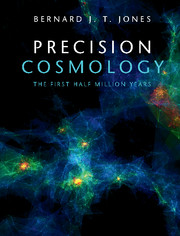Book contents
- Frontmatter
- Dedication
- Contents
- Preface
- Notation and Conventions
- Part I 100 Years of Cosmology
- Part II Newtonian Cosmology
- Part III Relativistic Cosmology
- Part IV The Physics of Matter and Radiation
- Part V Precision Tools for Precision Cosmology
- 23 Likelihood
- 24 Frequentist Hypothesis Testing
- 25 Statistical Inference: Bayesian
- 26 CMB Data Processing
- 27 Parameterising the Universe
- 28 Precision Cosmology
- 29 Epilogue
- Appendix A SI, CGS and Planck Units
- Appendix B Magnitudes and Distances
- Appendix C Representing Vectors and Tensors
- Appendix D The Electromagnetic Field
- Appendix E Statistical Distributions
- Appendix F Functions on a Sphere
- Appendix G Acknowledgements
- References
- Index
24 - Frequentist Hypothesis Testing
from Part V - Precision Tools for Precision Cosmology
Published online by Cambridge University Press: 04 May 2017
- Frontmatter
- Dedication
- Contents
- Preface
- Notation and Conventions
- Part I 100 Years of Cosmology
- Part II Newtonian Cosmology
- Part III Relativistic Cosmology
- Part IV The Physics of Matter and Radiation
- Part V Precision Tools for Precision Cosmology
- 23 Likelihood
- 24 Frequentist Hypothesis Testing
- 25 Statistical Inference: Bayesian
- 26 CMB Data Processing
- 27 Parameterising the Universe
- 28 Precision Cosmology
- 29 Epilogue
- Appendix A SI, CGS and Planck Units
- Appendix B Magnitudes and Distances
- Appendix C Representing Vectors and Tensors
- Appendix D The Electromagnetic Field
- Appendix E Statistical Distributions
- Appendix F Functions on a Sphere
- Appendix G Acknowledgements
- References
- Index
Summary
In this chapter we cover one particular aspect of frequentist statistics in order to be able to compare and contrast the approach with the Bayesian approach that we shall be discussing shortly. In much of the world that uses statistics, the principle objective appears to be to test hypotheses about given data and come to some conclusion. The conclusion might be the answer to either of the questions: ‘Is this supported by the data or not?’, or ‘Which is the better descriptor of the data?’. Control samples are commonly used as an alterrnative against which the data will be evaluated. Whatever the question, the questioner expects a quantitative answer.
In cosmology we only have the one Universe as a source of data, and we have no other Universe that can act as a control. Of course we do have numerical simulations that can play that role. Our goal is often to fit a parameterised model to data and we can reasonably ask how confident we should be that this is the ‘best’ answer.
Classical Inference
In generic terms, the goal of statistical analysis is to discover how some factor Y responds to changes in some input, or set of inputs X. The observations (x, y) are paired, and while the values of x are generally under control of the experimentalist, the response y is subject to measurement errors ∊. The mechanism for doing this may take the form of establishing a model for the dependence of Y on X, or might be to discover which of the factors X, or which combination of the elements of X, are the main contributory factors to the response Y. Here we will consider only the first of these, fitting parameterised models.
Linear Regression
The simplest data model, linear regression is commonplace and involves determining parameters α and β in the relationship of the form
Y = AX + ∊, (24.1)
where the experiment consists of observing the values of Y, the response, resulting from treatmentsX. The observations Y are subject to errors ∊.
- Type
- Chapter
- Information
- Precision CosmologyThe First Half Million Years, pp. 567 - 581Publisher: Cambridge University PressPrint publication year: 2017

